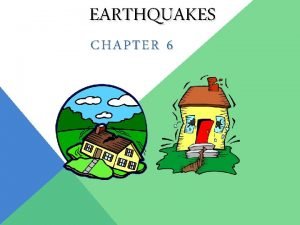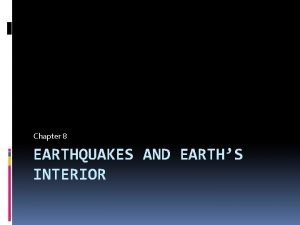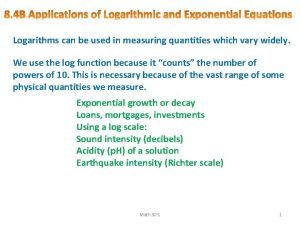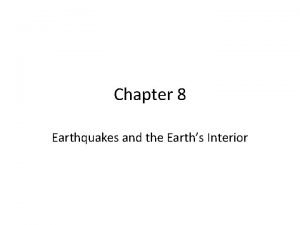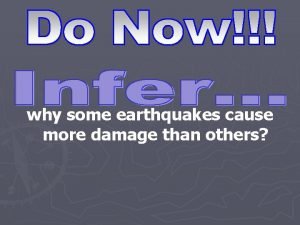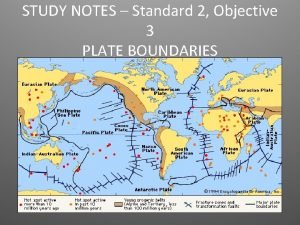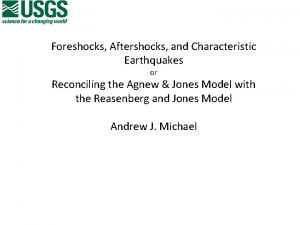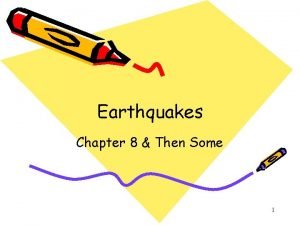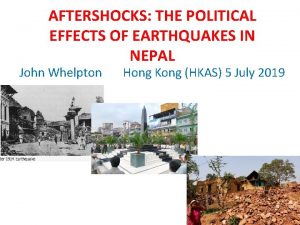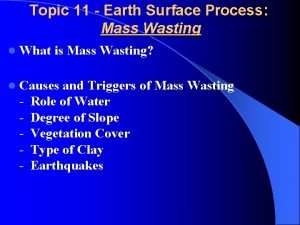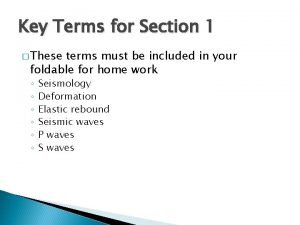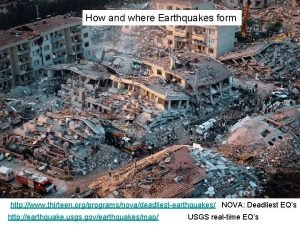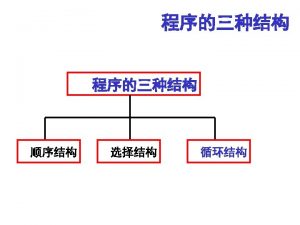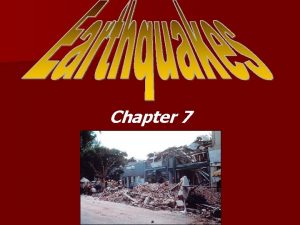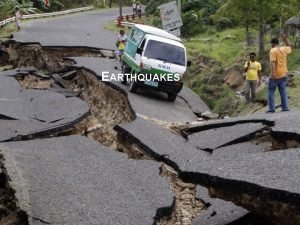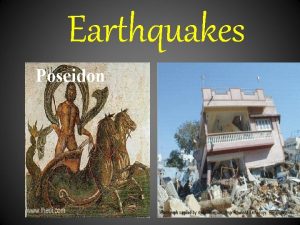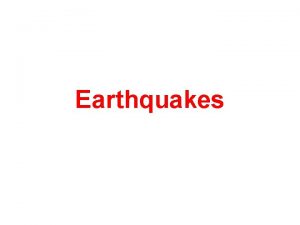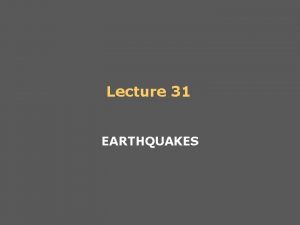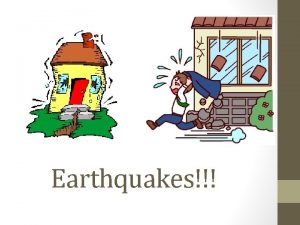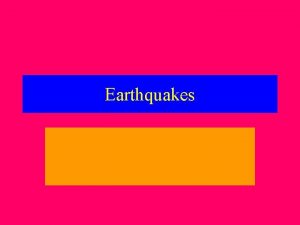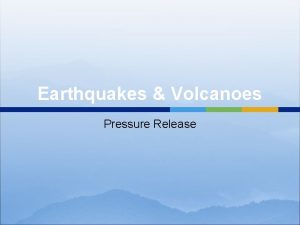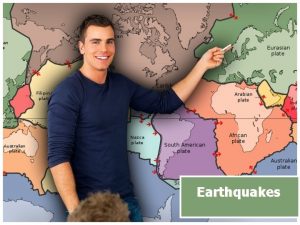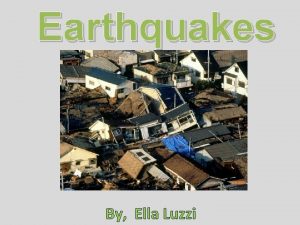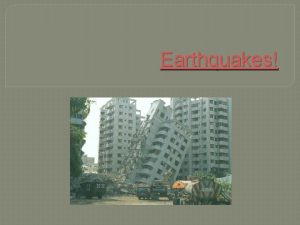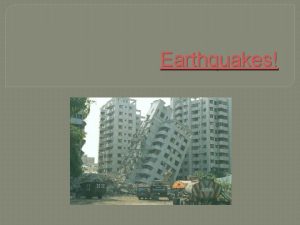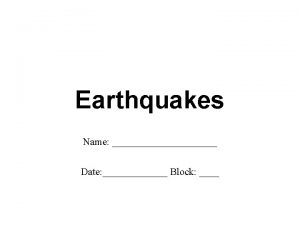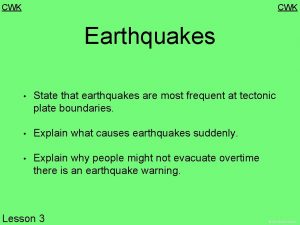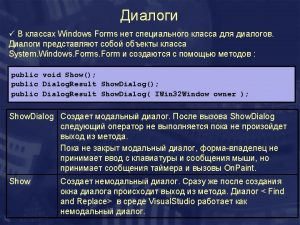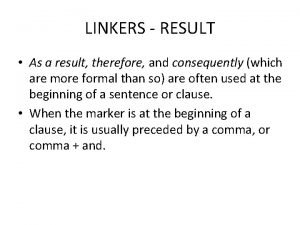Earthquakes Earthquakes KEY IDEA Most earthquakes result from





























- Slides: 29

Earthquakes!!! � Earthquakes

KEY IDEA Most earthquakes result from the release of stress that has built up at plate boundaries.

Earthquake Facts �More then 3 million earthquakes occur each year, or about one earthquake every ten seconds!

Earthquake Facts � Most of these earthquakes are too small to be noticeable. Each year, however, a number of powerful earthquakes occur. Because such earthquakes are the most destructive of natural disasters, it is important to understand how and where they occur.

Earthquakes!!! � An earthquake is a shaking of Earth’s crust caused by a release of energy. � The cause of most major earthquakes is the strain that builds up along faults at or near boundaries between lithospheric plates. TLC : : Earthquakes: Make a Quake

Faults �A fault is a break in the lithosphere along which movement has occurred.

Causes of Earthquakes �Most of the time, friction prevents the plates from moving so strain builds up, causing the plates to deform, or change shape.

Causes of Earthquakes � Eventually the strain becomes so great that it is able to overcome the force of friction. The plates move suddenly causing an earthquake. This is known as the elastic rebound theory.


Earthquakes for Kids





Haiti Earthquake Aftermath Rare Earthquake Hits Haiti

Focus � The point at which the first movement occurs during an earthquake is known as the focus of the earthquake. � The focus is usually located several kilometers under the Earth’s surface.

Epicenter � The point on Earth’s surface directly above the focus is known as the epicenter. � News reports on earthquakes usually give the location of the epicenter. Earthquakes for Kids


Body Waves � The energy released in an earthquake travels in waves. � Waves that travel from the focus of an earthquake through earth are called body waves.

Body Waves � There are 2 types of body waves: � Primary (P waves) � Secondary (S waves)

P Waves P waves are known as compressional or primary waves. � They squeeze and stretch rock material as they pass through. � P waves travel the fastest of all seismic waves. � They can travel through any type of material: solid rock, magma, water and air. �

S Waves S waves are known as shear or secondary waves. � They move at right angles to the direction in which the waves are traveling. � S waves travel slightly slower then P waves. � They can travel through solid material but not liquids or gases. �

Observe animations of earthquake waves.

Identify the types of waves below:

Surface Waves �Surface waves are waves that travel along earth’s surface. �They cause the most damage during an earthquake.

Seismograph �A seismograph is used to determine the magnitude of an earthquake and the location of its epicenter.


Locating the Epicenter � Once you determine the distance from the seismic station to the epicenter, you could draw a circle around that station to show the possible epicenter locations.

Locating the Epicenter � To locate the epicenter exactly, you need 3 stations to all do the same thing. You will end up with 3 circles that only meet in 1 location: the epicenter.
 What are the factors of earthquake
What are the factors of earthquake Chapter 8 section 2 earthquake measurement answer key
Chapter 8 section 2 earthquake measurement answer key Chapter 8 earthquakes and earth's interior answer key
Chapter 8 earthquakes and earth's interior answer key Which phrase best describes the focus of ecology
Which phrase best describes the focus of ecology Theme vs. central idea
Theme vs. central idea Homiletical idea
Homiletical idea Contoh topic dan controlling idea
Contoh topic dan controlling idea What is the difference between topic and theme
What is the difference between topic and theme What is topic sentence example
What is topic sentence example A.1 determine the main idea of a passage
A.1 determine the main idea of a passage Penanda wacana adalah
Penanda wacana adalah Business model canvas examples
Business model canvas examples Key partners key activities key resources
Key partners key activities key resources In what section of earth do earthquakes happen
In what section of earth do earthquakes happen Btn earthquakes
Btn earthquakes Positive effects of earthquakes
Positive effects of earthquakes Http://earthquake.usgs.gov/earthquakes/map/
Http://earthquake.usgs.gov/earthquakes/map/ Chapter 8 earthquakes and volcanoes
Chapter 8 earthquakes and volcanoes A large crack in the earth formed by a river or earthquakes
A large crack in the earth formed by a river or earthquakes Chapter 8 earthquakes and earth's interior
Chapter 8 earthquakes and earth's interior Chapter 19 earthquakes
Chapter 19 earthquakes Why do some earthquakes cause more damage than others
Why do some earthquakes cause more damage than others Frequent earthquakes in an area may indicate
Frequent earthquakes in an area may indicate Earthquakes
Earthquakes Chapter 8 quiz 1
Chapter 8 quiz 1 Earthquakes
Earthquakes Mass wasting processes
Mass wasting processes Elastic rebound
Elastic rebound Why do earthquakes occur
Why do earthquakes occur Do earthquakes happen
Do earthquakes happen
